Living Space
Our love for turfgrass lawns and exotic plant species has turned urban America into an energy- and water-intensive “food desert” that doesn’t sustain the pollinators we depend on or the songbirds we enjoy watching. What can we do to return health and resilience to our nearby spaces? Plant habitat.
Habitat gardens are landscapes designed to provide food, water, shelter and community. They’re based on local native plants, and they mimic natural groupings in surrounding wildlands so that our nonhuman neighbors, including pollinators, recognize our yards as home.
Chickadees are a great example of how critical habitat is: Research by Desirée Narango at the Smithsonian Conservation Biology Institute shows these perky, black-capped songsters are declining in suburbia because they successfully reproduce only in landscapes dominated by native species. Like most songbirds, chickadees feed their young insects — lots of insects. Entomologist Douglas Tallamy, author of the popular book “Bringing Nature Home,” calculates one pair of black-capped chickadees requires 6,000 to 9,000 caterpillars per brood. Native plants have long-term relationships with our indigenous insects and thus host insect buffets; exotic plants by and large do not.
Native plants call in pollinators, birds and other wildlife, from microbes to reptiles, by broadcasting “come hither” scents on the airwaves and signaling to fauna with characteristic colors and forms. And as forest researcher Dr. Suzanne Simard of the University of British Columbia points out, native plants work below ground too, connecting plants in a communications web to foster community health, retain carbon in the soil, and maintain resilience in the face of change. (More on that here and here.)
Audubon Rockies Habitat Hero co-founder Connie Holsinger tells how this “plant it and they will come” effect lured hummingbirds to her construction-bared suburban lot: “As soon as [we] unloaded a blooming scarlet gilia (Ipomopsis aggregata), my first-ever hummingbird zipped right in.” The bird hovered next to the flower spike, chattering, and followed the nectar plant it recognized as food into her yard.
Designing a habitat garden is as simple as carving out a section of lawn and planting natives. It begins with knowing the characteristics of your site, including exposure and soil. To learn what plants are native to your area, take a field trip with an organization such as the Native Plant Society of Texas (or your local equivalent) or consult the Wildflower Center’s Native Plants of North America database. Also get a feel for your regional terroir, the “flavor” of nature: Which plants grow together and in what patterns? Are the wild landscapes around you prairie? Scrubland? Woodland or forest? That assemblage of local characteristics will inform the design of your habitat garden.
For specific ideas, visit public gardens with habitat plantings and take notes and photos. Stroll the Texas Native Trail at San Antonio Botanical Garden for an introduction to three bioregions: the shaded Pineywoods of East Texas, the meadow-dominated Hill Country, and the characteristic shrubs of the South Texas scrublands. Explore the desert’s diversity at the Chihuahuan Desert Research Institute’s botanical garden outside Alpine. Wander the waving expanses of restored native prairie at the Botanical Research Institute of Texas in Fort Worth. Or ramble the Pollinator Habitat and Nectar Gardens at the Wildflower Center.
All of these inspirational examples embrace four basic components of habitat gardening. With tips from experts at public and private gardens, here’s a primer on how to incorporate them into your own outdoor spaces.
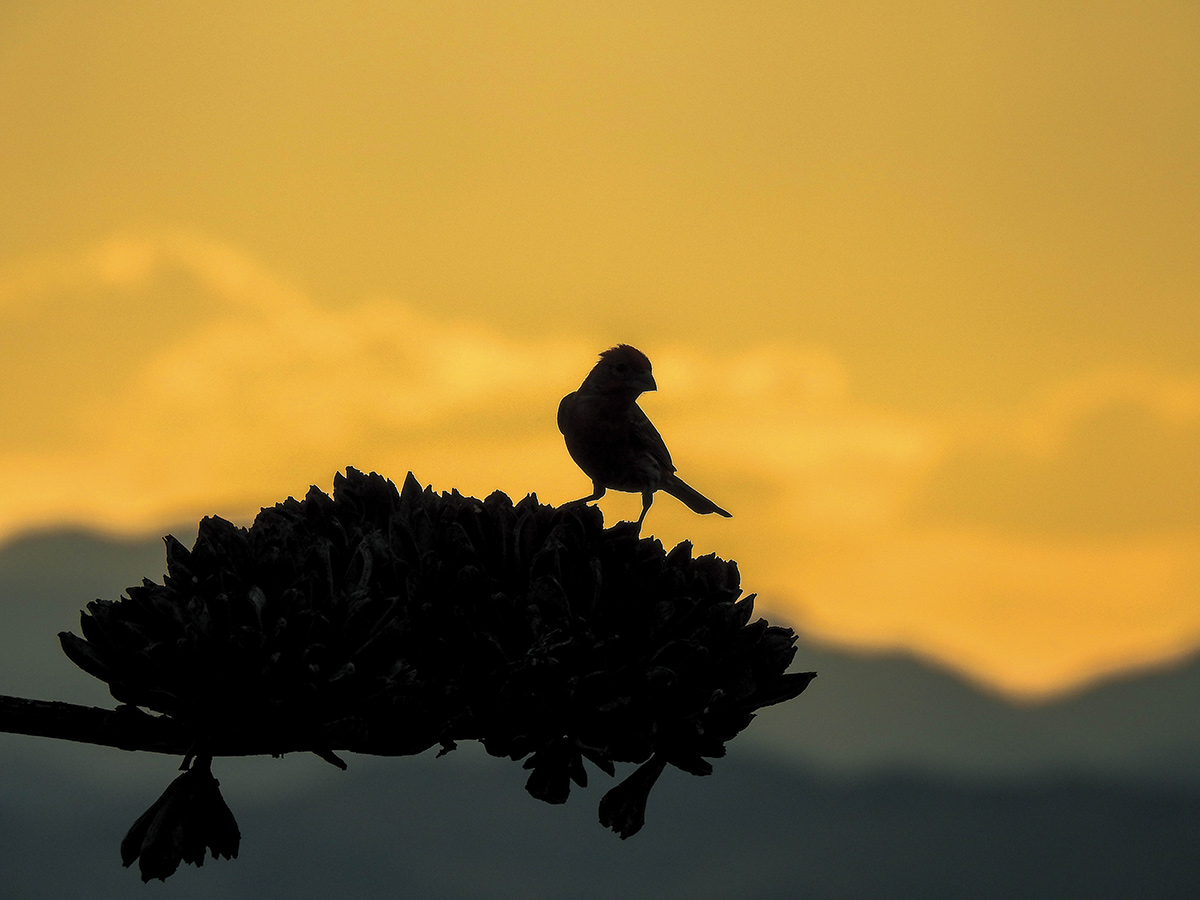
Blooming agaves provide high-energy nourishment in the form of nectar for bird and bat populations. PHOTO Andy Morgan Photography
Food
Providing food for fauna means growing plants that offer complete nutrition — seeds, fruits, pollen, nectar, browse (twigs and shoots of young trees and shrubs) and insects for protein — not just hanging feeders. Where a hummingbird feeder provides hydration and the quick energy of simple sugars, for instance, the flowers on a Salvia plant offer the same hydration plus a longer-burning mix of carbs, not to mention protein from insects stuck in nectar as well as lipids and vitamins from stray pollen grains — in other words, a full meal. Food plants are often region specific: The best species for West Texas won’t necessarily work in the Pineywoods of the East or on the Gulf Coast.
The Wildflower Center’s director of horticulture, Andrea DeLong-Amaya, suggests selecting plants that offer different types of food and designing your habitat to furnish it year-round. She recommends plants in the aster family (Asteraceae) for their appeal to a wide variety of pollinators and songbirds over a long season, including butterflies (nectar), native bees (pollen and nectar), and songbirds (fat-rich seeds).
She particularly likes common sunflower (Helianthus annuus), a simple-to-grow annual that can thrive almost anywhere. “They attract dozens of kinds of native pollinators,” she says, “and watching goldfinches pry out seeds is pure entertainment.” She also recommends frostweed (Verbesina virginica), a tall perennial with clusters of small, white flower heads especially attractive to butterflies (including monarchs). Named for the sculptural ribbons of ice that form on its stalks during freezing weather, frostweed thrives in part shade.
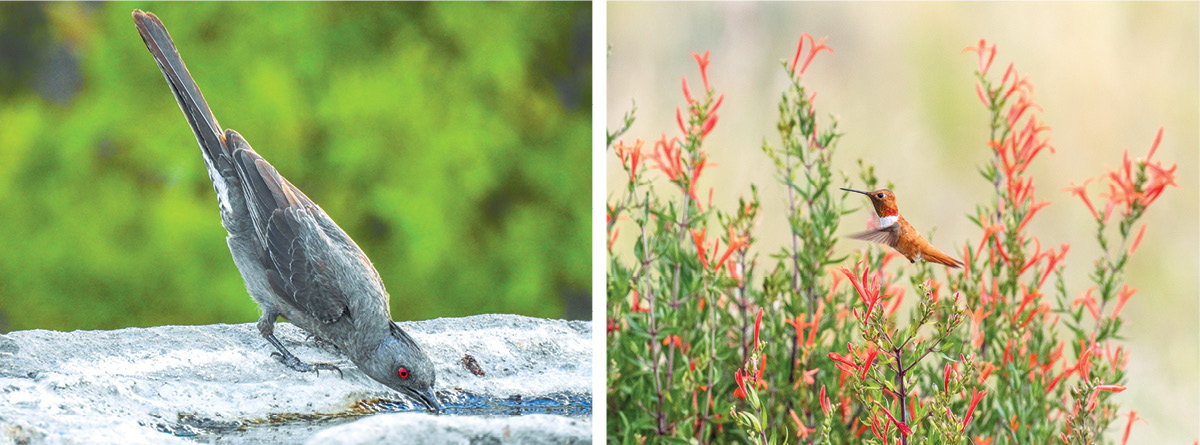
LEFT A female phainopepla takes a drink at the Chihuahuan Desert Research Institute. PHOTO Andy Morgan Photography RIGHT A male rufous hummingbird visits flame acanthus, which attracts birds and pollinators with both its color and flower shape. PHOTO Hal Livings
At the Chihuahuan Desert Research Institute’s botanical garden, Head Gardener Seth Hamby points out that desert gardens are not limited to “agaves, cacti and gravel.” Hamby recommends Texas kidneywood (Eysenhardtia texana), an aromatic shrub or small tree that is native to Central and West Texas and the Rio Grande plains. Kidneywood’s spikes of white flowers have a long bloom period and are frequented by native bees; plus, the leaves are eaten by caterpillars of dogface sulfur butterflies. Hamby also likes the many native sumac (Rhus) species, which provide nectar for pollinators, nutrient-rich berries to sustain birds in migration, and gorgeous fall foliage.
The Nature Conservancy’s Jaime González, director of Houston’s Healthy Cities Program, nurtures a front yard prairie. His species recommendations include Texas bluebonnet (Lupinus texensis), which reseeds itself; golden tickseed (Coreopsis tinctoria) for butterflies; pink evening primrose (Oenothera speciosa); and Maximilian sunflower (Helianthus maximiliani) for late-season pollinators, birds and small mammals.
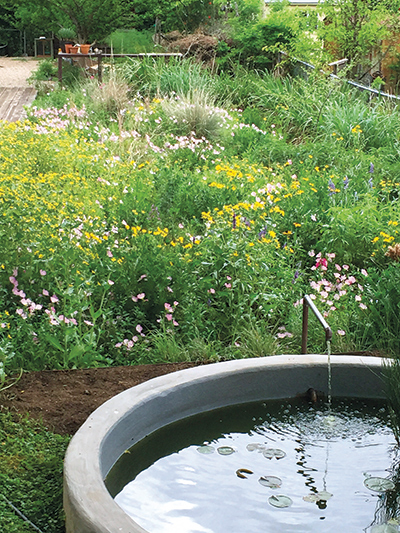
Wildflower Center Environmental Designer John Hart Asher added this water feature to his backyard prairie and stocks it with native fish. PHOTO John Hart Asher
Water
While we might all wish for a babbling brook like the Hill Country Stream in the Wildflower Center’s Woodland Garden or a lake like the one at San Antonio Botanic Gardens, a water feature doesn’t have to be large or expensive to be effective.
Providing water can be as simple as using a dish that doesn’t have a drain, says the Center’s DeLong-Amaya. Refresh the water frequently, and maximize its availability for wildlife by keeping it from freezing. For butterflies, add gravel and fill with water to the gravel’s top. Shallow water is best for lizards and smaller insects that can drown in more depth. “Or use a rock with a natural depression that will hold water,” says DeLong-Amaya. Birds are attracted to the sound of dripping water, she notes, which can come from a drip emitter.
The Center’s stock tank “pond” is a great example of a larger but still simple water feature: “You don’t need a pump or filter,” says DeLong-Amaya; “you just need fish to eat the mosquito larvae.” A flat rock placed at the water’s surface serves as both bird bath and “rescue platform” for toads and other animals that can’t climb the slippery sides of the tank.
Capturing runoff from an existing building also works. At San Antonio Botanical Garden, the Bird Watch Structure includes a cistern that collects rain from the roof. Water from the cistern flows into a trough near the viewing windows and then drips into a bird bath. In Houston, González channels the condensate from his home air conditioner into a tiny pond where toads breed.
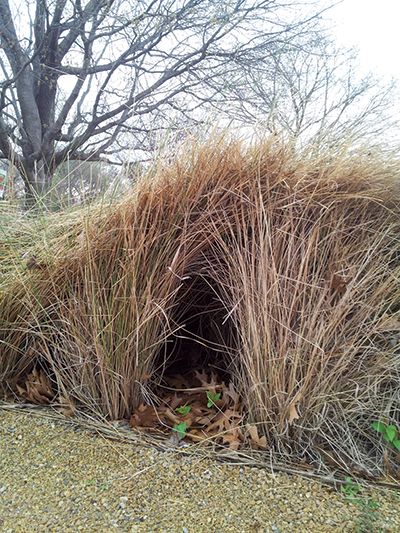
Native grasses such as Muhlenbergia species create natural cover and protection for all sorts of fauna, from small mammals and birds to insects and reptiles. PHOTO Courtesy of BRIT
Shelter
Shelter means a place to escape from inclement weather, be that rain, snow, wind or heat; places for nesting or wintering; and protection from predators. Think in terms of layers: What’s the natural overstory where you live? Trees? Shrubs? Tall grasses? What’s the plant spacing: close together or widespread? How do the different layers from groundcover to canopy interact, both vertically and horizontally? Is the ground in natural areas covered with leaf or needle litter or partly bare? Echoing those patterns will make your habitat garden attract more pollinators, songbirds and other wildlife.
Bare ground, for instance, is necessary as nesting habitat for many species of native bees. Bark flakes can be cozy winter homes for some insects; dried grass or wildflower stems serve as cavities for others. Growing a diversity of plants means you’ll have a variety of materials for nesting, from fine grass blades to acorn shells. Attracting certain fauna can provide fodder for others: Hummingbirds use spider webs, for instance, like spandex fiber to weave their stretchy nests. Save tidying until spring, making seeds, fallen leaves and dried stems available for winter visitors.
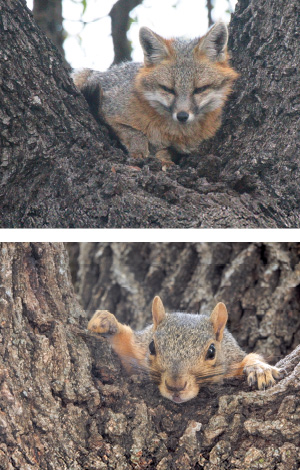
Oak trees adjacent to BRIT’s restore prairie host such frequent visitors as this native gray fox (top) and eastern fox squirrel; the latter was hiding from a red-shouldered hawk in this image, according to Facilities Manager Greg Gunn. PHOTOS Courtesy of BRIT
At the Botanical Research Institute of Texas, a restored prairie with a grassy overstory now waves in summer breezes on what once was a 2.7-acre parking lot. To transform the degraded site into prairie, BRIT researchers drilled seeds of 35 native grass and wildflower species into the compacted soil; they also aided sprouting and survival by inoculating the soil with microorganisms from nearby prairies.
Greg Gunn, BRIT facilities manager, says that as soon as the first grasses sprouted, wildlife appeared: “Almost right away we noticed dragonflies and other flying predators. Then the snails showed up — the species you only see on prairies. Worms and beetles and grasshoppers joined the party … and birds, not the usual urban blue jays and mockingbirds but kingbirds, scissortail flycatchers, bluebirds, indigo buntings and little sparrows I had to research to identify.” He also mentions kestrels and red-shouldered and red-tailed hawks.
BRIT’s prairie wildlife list now boasts numbers in the hundreds, from pearl crescent butterflies to coyotes — all living where a parking lot once baked in the sun.
To restore prairie in your yard, Gunn advises, “Go walk a prairie remnant in your area and get the look and feel, the sound and smell.” He adds, “Start with one of the colonizing grasses, like silver beardgrass [Bothriochloa laguroides ssp. torreyana], which will grow just about anywhere.” (Find more tips from the Wildflower Center here.)
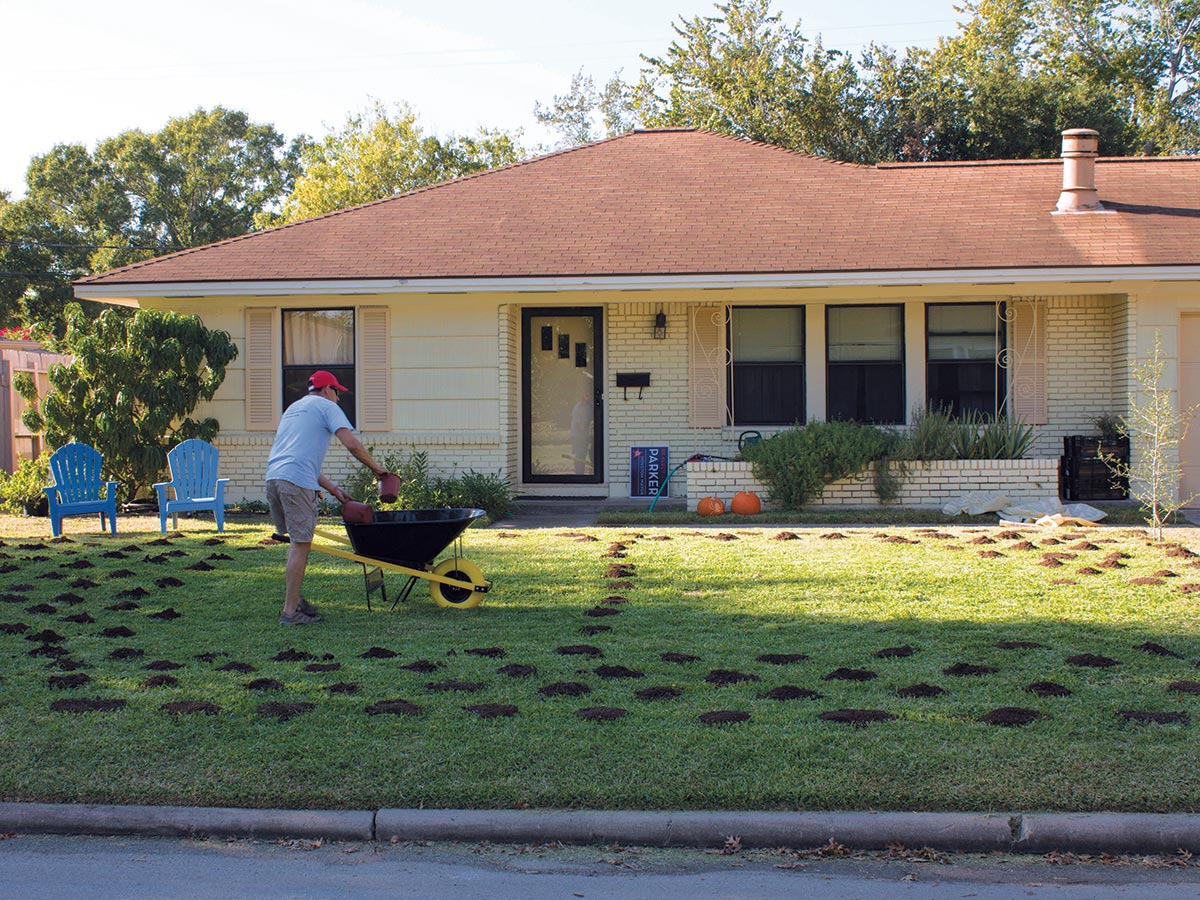
Jaime González adds “dirt patties” to his front yard every October and sprinkles them with native wildflower seeds with the help of family and neighbors. PHOTO Jaime González/The Nature Conservancy
Community
Community grows from the relationships between species, which give natural landscapes and habitat gardens their distinctive regional flavor.
In the Chihuahuan Desert of Carlsbad, New Mexico, retired National Park Service botanist Renee West began converting her Bermudagrass lawn to a vibrant desert habitat 20 years ago. She removed the invasive grass and planted over 100 species of desert plants.
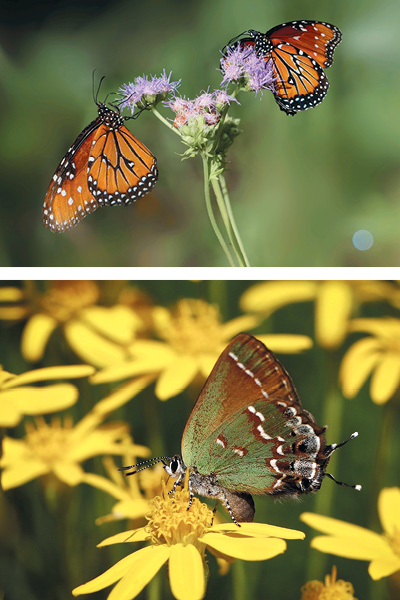
Queen butterflies visit Gregg’s mistflower (top), and a juniper hairstreak sips nectar from damianita, both at the Wildflower Center. PHOTOS Julie Shaw
“I didn’t want it to be a garden; I set out to create a habitat,” she says, “which meant letting the plants grow where they do best.” The slimlobe globeberry (Ibervillea tenuisecta) she initially planted died, but another sprouted in a different place in the yard; a vine in the squash family, it grew a huge tuber over the years. Today, her desert yard boasts dozens of wildflowers, grasses and shrubs under an overstory of netleaf hackberry (Celtis laevigata var. reticulata). Her birder husband has recorded more than 140 species of birds in the yard.
The Nature Conservancy’s González is reviving Houston’s forgotten prairie. He has created more than 30 prairies with the help of partners, including Hatton Spring Prairie, the seasonal prairie in his urban front yard. From June through September, González mows the area like a conventional lawn. Come October, he and his family form “dirt patties” about a foot square, sprinkle them with native wildflower seeds, and invite neighbors to stomp the seed in to help it sprout. The prairie flourishes without mowing until June, when the grassland is cut to lawn length again.
Hatton Spring Prairie, located near the busy Texas Medical Center and the Houston Livestock Show and Rodeo grounds, is a very public demonstration of habitat gardening. González posts interpretative signs to educate passersby about the nontraditional landscaping. “Much of the bloom coordinates with the stock show and rodeo,” he says, “so we can point out that this land used to be a prairie and a ranch.” He and his family like to set up lawn chairs in the front yard, sit out there and watch what they call “bee TV.” Being present offers his family a way of connecting with their neighbors and the opportunity to do some prairie evangelizing.
he benefits of habitat gardens go far beyond hosting pollinators and other ecologically important fauna. They include almost instant, gratifying results; plant a plot of Gregg’s mistflower (Conoclinium greggii) or damianita (Chrysactinia mexicana), and you’re sure to see beautiful butterflies. That’s a rich payoff. They also include the civic engagement González finds so satisfying, along with the joy of raising his young son where dragonflies, toads and birds find a home, grounded in nature. As Dr. Simard says, “Restoring habitat can restore connection and resilience in our communities.” In other words, birds and bugs give us something to talk about, to wonder at, and — by planting native gardens — something to come together in creating and supporting.
Susan J. Tweit is the author of “Walking Nature Home” and several other books. Learn more and read her work at susanjtweit.com.

